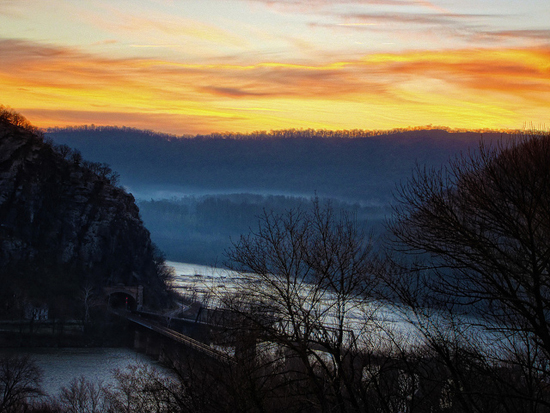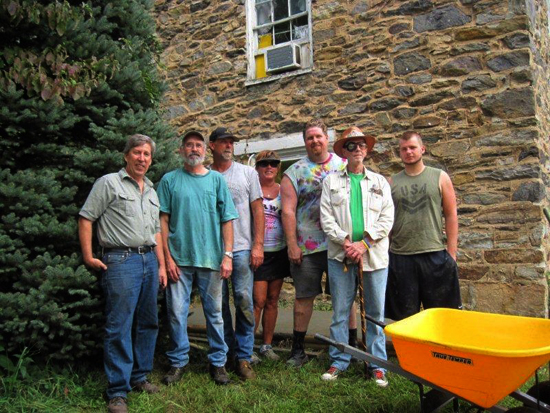Watershed Wednesday: Blue Ridge Watershed Coalition (Jefferson County, W.Va.)
The Blue Ridge Mountains face challenges from stormwater runoff.
In Jefferson County, W.Va., shaded streams trickle down the Blue Ridge Mountains into what will become the Potomac or Shenandoah rivers. The ridge is named “blue” for its characteristic purple-blue haze. No, this isn’t some kind of rural smog, but isoprene, which the trees on the mountain release into the atmosphere.

Image courtesy Eoghann Irving/Flickr
Despite the pristine scenery found in this part of the Chesapeake Bay watershed, a visit to Jefferson County on a rainy day can expose a darker side. Thanks to aging infrastructure, the county has faced flooded roads and a river that carries an unknown amount of pollutants.
Residents knew they had to take action to ensure their mountain’s health. So, the Blue Ridge Watershed Coalition was born. And in just over 18 months, the non-profit organization has arranged stream cleanups, showcased stormwater management practices and monitored water quality in a stretch of the Shenandoah River.
Why monitor water quality?
To monitor water quality, biologists take water samples from a stream or river and send them into a lab. There, the amount of pollutants in the water is measured. Monitoring a series of sites in a single waterway can tell us where these pollutants might be coming from.
Before the Blue Ridge Watershed Coalition was formed, monitoring in the Shenandoah River was completed by a single Shenandoah University professor. Now, the college will train coalition volunteers to take water samples, as the coalition works to determine pollution sources and track the river’s long-term health.
“Our friends and neighbors on the mountain had very adamantly voiced that they wanted real facts as to what is in our lovely Shenandoah River,” explained Ronda Lehman, Blue Ridge Watershed Coalition Chair.
“We hope our river monitoring will help delineate whether our issues are born from our county’s farms, septic tanks or stormwater runoff, or a combination,” said Ronda.
Curbing runoff, preventing floods
Close to 17,000 commuters leave Jefferson County, W.Va., for Washington, D.C., each morning, and many of them travel on Route 9. But this road often floods, as it collects stormwater runoff from surrounding properties.
The Blue Ridge Watershed Coalition hopes to curb the amount of runoff coming from one of these properties—an old stone church now called the Mountain Community Center.
“A little calculating showed us that there are 1,400 gallons of water that run off the roof of the church during average rain events,” said Ronda.
The coalition will divert rainwater from the roof of the building into rain barrels and cisterns and curb the flow of sediment and stormwater with a filter installed at the end of the driveway.

Image courtesy Blue Ridge Watershed Coalition/Facebook
“Incorporating different methods of mitigating that flow of water would give us an opportunity to showcase different practices for our neighbors to incorporate onto their own properties,” Ronda said.
River cleanups
If water quality monitoring and stormwater management seem too “scientific” for your tastes, then an old-fashioned trash cleanup could be for you! The Blue Ridge Watershed Coalition held its second annual cleanup in July.
The cleanup area is popular among the public, but has a history of being dirty.
The coalition hopes to amend this littering problem. “We will be purchasing banners to be placed at the busy ‘put ins’…to remind patrons to take their trash with them," said Ronda.

Comments
Great news. Thanks so much for the update on your work!
Thank you so much for featuring the efforts of our local volunteers. They work so hard and give so much of their time to this effort.
Our first big project at the Mountain Community Center (the church mentioned in the article) is now complete, and with the help of Hurricaine Sandy, we know that we have been successful!
We had a community picnic to unveil the project and tour people through the methods we used to keep the water on the property.
We are looking forward to the spring when our prairie rain garden blooms in this highly visible location. We are hoping the beauty of the rain garden and the obvious absence of the hydroplaning issue will inspire our neighbors to incorporate some of the methods to help keep our watersheds clean.
Thank you!
Your comment has been received. Before it can be published, the comment will be reviewed by our team to ensure it adheres with our rules of engagement.
Back to recent stories